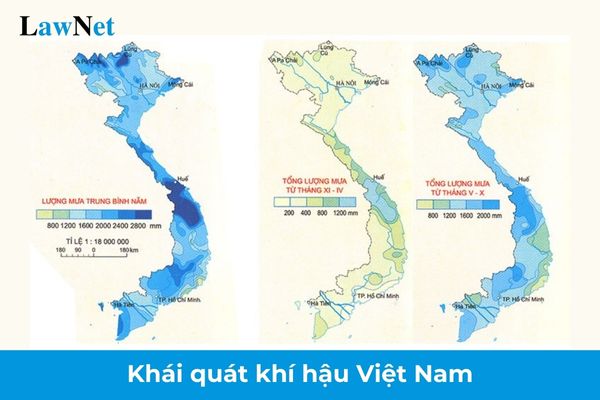What is the overview of Vietnam's Climate for the 8th-grade History and Geography curriculum? What learning outcomes are required for climate and hydrological characteristics of Vietnam for 8th-grade students?
What is the overview of Vietnam's Climate for the 8th-grade History and Geography curriculum?
An overview of Vietnam's climate not only helps to better understand the natural conditions but also explains the country's economic and social characteristics. Students can refer to the following overview of Vietnam's Climate for the 8th-grade History and Geography curriculum:
Tropical Monsoon Climate
Tropical Characteristics
- The tropical characteristics of Vietnam's climate are evident through:
+ The annual average temperature across the country is above 20°C (except for high mountainous areas), and it increases gradually from North to South.
+ Sunshine duration ranges from 1400 to 3000 hours per year; the radiation balance ranges from 70 to 100 kcal/cm²/year.
Humidity Characteristics
- Our country has high air humidity, averaging above 80%.
- High rainfall, ranging from 1500 to 2000 mm per year on average.
Monsoon Characteristics
- Vietnam is located in the operation range of the Northern Hemisphere Trade Winds. Additionally, the country is strongly influenced by air masses operating seasonally:
- Winter monsoon:
+ Operating time: from November to April the following year.
+ The North is affected by cold air masses moving down from the North, creating a cold winter (the first half of winter is cold and dry; the second half is cold and humid).
+ South of the Bach Ma range, the northeast trade winds are dominant, causing rain on the South Central Coast. Meanwhile, the Central Highlands and Southern regions have hot, dry weather.
- Summer monsoon:
+ Operating time: from May to October.
+ Primarily from the southwest direction.
+ At the beginning of summer, the southwest wind from the North Indian Ocean causes heavy rain in the Southern Delta and Central Highlands. When passing over the Truong Son range and mountain ranges along the Vietnam-Laos border, the wind's characteristics change due to the foehn effect, causing the east of the Truong Son and the southern Northwest regions to experience hot, dry weather.
+ In the middle and end of summer, the southwest monsoon originating from the Southern Hemisphere moves northward, combining with the impact of the intertropical convergence zone, creating hot, humid weather with widespread rain. Extreme weather phenomena during this season include typhoons accompanied by heavy rain.
Diverse Climate Differentiation
Differentiation from North to South:
- Northern climate region, from the Bach Ma range outwards:
+ The annual average air temperature is above 20°C.
+ Cold winter (the first half of winter is relatively dry, and the second half is wet); hot, humid, and rainy summer.
- Southern climate region from the Bach Ma range inward:
+ The annual average air temperature is above 25°C with no month below 20°C, and the annual average temperature range is less than 9°C.
+ Distinct division into two seasons: rainy and dry.
Differentiation from East to West
- East to west differentiation shows the climate differences between coastal and mainland areas, between eastern plains and western mountains.
+ Coastal and continental shelves have a milder climate than inland.
+ Coastal plains have a tropical monsoon climate.
+ The western mountainous regions have complex climate differentiation due to the impact of monsoons and mountain range orientation.
Differentiation According to Altitude
- From low to high, our country has three climatic belts.
+ At low altitudes (Northern region up to 600-700 m, Southern region up to 900-1000 m), the climate is tropical monsoon. Summer is hot, with average summer month temperatures over 25°C. Humidity and rainfall vary by location.
+ Higher up (below 2,600 m), there is a subtropical monsoon climate in the mountains. Monthly average temperatures are below 25°C, with increased rainfall and humidity.
+ From heights above 2,600 m, there is a temperate monsoon climate on the mountains, with all months having average temperatures below 15°C.
Seasonal Differentiation
- Summer sees the activity of the southwest monsoon.
- Winter sees the activity of the northeast monsoon.
Note: Contents are for reference purposes only.

What is the overview of Vietnam's Climate for the 8th-grade History and Geography curriculum? What learning outcomes are required for climate and hydrological characteristics of Vietnam for 8th-grade students? (Image from Internet)
What learning outcomes are required for climate and hydrological characteristics of Vietnam for 8th-grade students?
Under Section 5 of the General Education Program for History and Geography at the Lower Secondary Level issued with Circular 32/2018/TT-BGDDT, learning outcomes required for climate and hydrological characteristics of Vietnam for 8th-grade students include:
- Describe the tropical monsoon climate characteristics of Vietnam.
- Draw and analyze climate graphs of stations belonging to different climate regions.
- Demonstrate the diverse differentiation of Vietnam's climate.
- Analyze the impact of climate change on Vietnam's climate and hydrology.
- Find examples of solutions to respond to climate change.
- Identify on a map the basins of major river systems.
- Analyze the network characteristics of rivers and water policies of some major river systems.
- Analyze the role of lakes, ponds, and groundwater for production and daily life.
- Analyze the impact of climate on agricultural production.
- Analyze the role of climate in tourism development at some famous tourist spots in our country.
- Give examples to demonstrate the importance of integrated water resource management in a river basin.
What is one of the most important methods to study 8th-grade Geography in Vietnam?
Under Section 6 of the General Education Program for History and Geography at the Lower Secondary Level issued with Circular 32/2018/TT-BGDDT, one of the most important methods to study 8th-grade Geography in Vietnam is to practice the skills of using learning tools:
- Maps, atlasses, charts, statistical data tables
- Some phone applications like compass, navigation maps, global positioning system, thermometer, hygrometer, barometer, etc.
- Pictures, DVDs for multi-method material search, e-books, etc.

